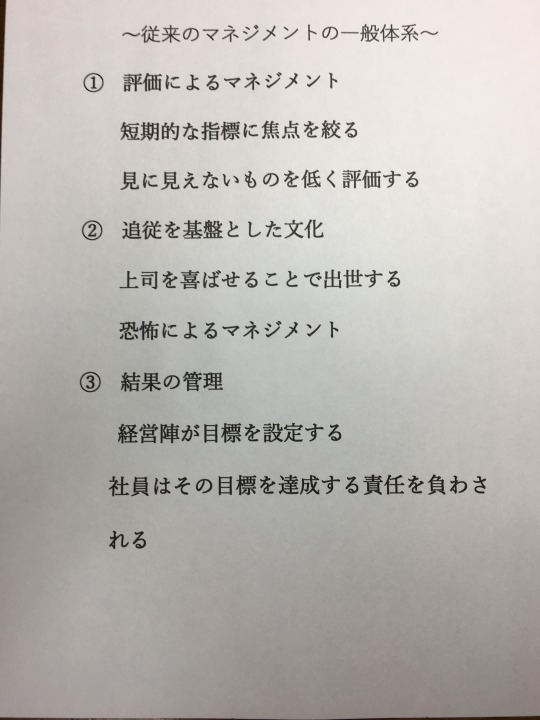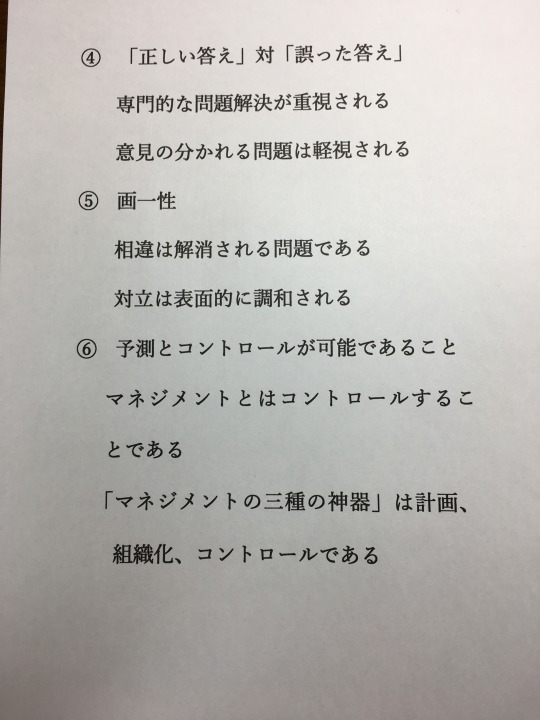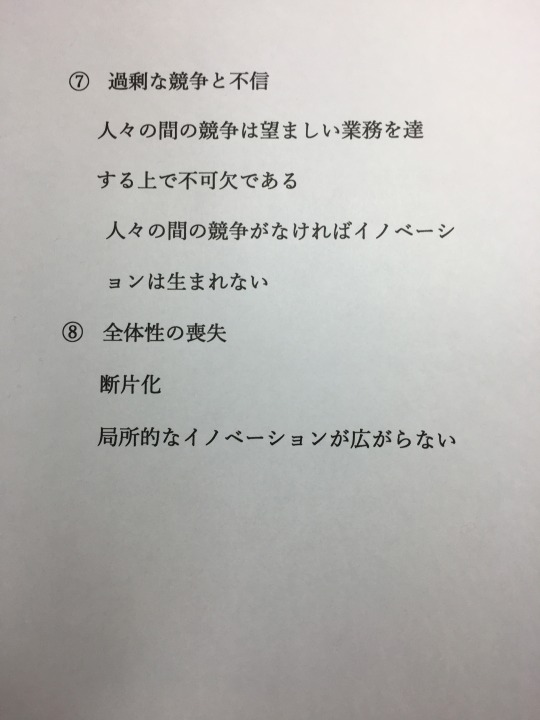#peter senge
Explore tagged Tumblr posts
Text
1973- En un contexto turbulento como el actual, nadie puede sentirse fuerte por lo que es. La única fortaleza posible es la que proviene de ser capaz de responder, de dejar de ser lo que se es para ser lo que sea necesario.
(Peter Senge)
#textos nocturnos#pensamientos#vida#culture#frases#textos#books & libraries#escritos de amor#palabras#amor#ser humano#fortaleza#libertad#lagrimas#Peter Senge
22 notes
·
View notes
Text
学習する組織入門
学習する組織は「PDCAサイクルをなぜ回すことがそれほど難しいのか?」を体系的にまとめ上げた組織学習論です。あなたは「PDCAサイクルを回すなんてあたりまえじゃないか!」と思われるかもしれませんが、PDCAサイクルを回ることは実は困難を極めることなのです。なぜなら、みんながPDCAサイクルを回せるのであれば、みんながやり抜く力を発揮している超一流の人間になっているからです。では、そもそもなぜPDCAサイクルを回すことはそれほど難しいのでしょうか?この点について学習する組織の提唱者であるピーター・M・センゲは(以下敬愛の念を込めてセンゲ先生と記します)は人々からやる気が喪失しているからだと述べています。このやる気スイッチのオフ状態について従来やる気がないのは自己責任であるとされてきました。その最たるものがやり抜く力の提唱者であるアンジェラ・ダックワースです。しかし、センゲ先生はやる気スイッチがオフ状態なのは組織の構造的欠陥にあると述べています。この構造的欠陥には系統的なパターンがあり、そのパターンのことをシステムの原型と呼んでいます。いわゆる、システム思考です。僕はこのシステム思考を知って、とても感動し、職場で使ってみようと思うようになりました。しかし、職場での反応は冷ややかなモノでした。この点について大変悲しく思いました。僕は��論的に正しいことを訴えているはずでした。なのに、周りの反応は芳しくありませんでした。このことについて、悩みました。そして、悩んで末にある結論に至りました。それは人が率先して”見ざる聞かざる言わざる”となり、そうすることでやる気スイッチのオフ状態になること(没個性的になること)と引き換えに自分を守っているということです。思い返してみてください。就活生の頃、あなたは青臭く、そして、泥臭かったはずです。しかし、社会人となって、社会人としての”まともさ”を身につけるに従い、やる気スイッチがオフ状態となったはずです。この先程申し上げた”まともさ”という言葉がキーワードなのです。そもそも社会人としての”まともさ”とは何を指すのでしょうか?それはまともな身だしなみ、まともなビジネスマナー、まともな従順さ、まともな共感力、まともな協調性、まともな理解力、まともな事務処理能力、まともなストレス耐性、まともな体力、まともな気力等です。これらが”まともさ”を構成しており、これらは人が本来持っているやる気スイッチを抑圧的に蝕みます。この抑圧的にという表現はフロイトが生み出した精神分析学の抑圧を意味します。つまり、社会人として生きていくに従い、気づかぬうちにやる気が喪失しているのです。また、この点について、あなたの無意識は自ら進んでやる気スイッチのオフと引き換えに”まともさ”を身につけることを選択しているのです。なぜでしょうか?それはみんながやる気スイッチのオフ(没個性的なること)と引き換えに”まともさ”を身につけることを選択しているからです。この同調圧力は極めて強固なものであり、あなたがこの同調圧力に抗してやる気スイッチをオンにしようとすれば、”KY”であるとみなされ、窓際族と化すでしょう。このことをあなたは無意識に理解しているため、自分自身を守るために”まともな道”を進んで選択しているのです。つまり、文字通り”出る杭は打たれる”のです。これに対して。天才は文字通り”出過ぎた杭は打たれない”をモットーとしています。近年の研究結果から人は誰もがやり抜く力を秘めている可能性があることが指摘されていますが、あなたがやり抜く力を持った一流を目指すのであれば、このようないばらの道が待ち受けていることを覚悟した方がいいでしょう。
最近になって日本は諸外国から”安い国”であるといわれています。その原因は学習する組織で述べられているように創造性と生産性の欠如にあるのではないかと思います。この点に関して僕なりの考えがあります。それは「なぜ多くの人がやる気スイッチがオフとなってしまうのか?」を理性的にではなく、感情的に共感し、周囲の人が”本当は”「どう活躍し、また、どのように生きたいのか?」を察する”やさしさ”です。この”やさしさ”をセンゲ先生は”愛”と表現しています。すなわち、本当は”知”とは経済的成功と権力掌握のための”力”ではなく、みんなの苦しみを察するためのマザー・テレ���が持ち合わせていたような”愛”なのです。あなたがシステム思考を理解したうえで、押し付けの善意ではない相手が本当に求めている”ヘルプ・ミー”の声を汲むことは少なからず試行錯誤が必要です。しかしながら、その格闘の中であなたがあなたらしく生き、そして、あなたの周囲の人がその人らしく生きることが可能となるはずです。これを急ぎすぎてはなりません。なぜなら、システムを改善するにはゆっくりと確実に解決することが求められるのですから・・・。
#学習する組織#経営学#mba#mba courses#mbacollege#peter senge#learning organization#mit#ビジネス#自己啓発本#自己啓発#自己肯定感#自己分析#自己実現
4 notes
·
View notes
Text
Transformando Organizaciones: El Poder del Aprendizaje Colectivo en “La Quinta Disciplina”.
“La quinta disciplina” de Peter Senge es un libro fundamental en el ámbito del liderazgo y la gestión organizacional. Publicado por primera vez en 1990, se centra en el concepto de “organización que aprende”, donde las empresas y sus miembros desarrollan continuamente su capacidad para crear el futuro que desean. El libro se estructura en torno a cinco disciplinas clave: Dominio Personal: Se…
#Aprendizaje Colectivo#Aprendizaje Organizacional#Cultura Empresarial#desarrollo personal#La Quinta Disciplina#liderazgo#Pensamiento Sistémico#Peter Senge
0 notes
Text


peter phillips, 1972 in le livre de l'aerographe: art, histoire et technique - seng-gye tombs curtis + christopher hunt (1980)
91 notes
·
View notes
Text
Opera on YouTube 6
Pagliacci
Franco Enriques studio film, 1954 (Franco Corelli, Mafalda Micheluzzi, Tito Gobbi; conducted by Alfredo Simonetto; no subtitles)
Tokyo Bunka Kaikan, 1961 (Mario del Monaco, Gabriella Tucci, Aldo Protti; conducted by Giuseppe Morelli; Japanese subtitles)
Herbert von Karajan studio film, 1968 (Jon Vickers, Raina Kabaivanska, Peter Glossop; conducted by Herbert von Karajan; no subtitles)
Franco Zeffirelli film, 1983 (Plácido Domingo, Teresa Stratas, Juan Pons; conducted by Georges Prêtre; English subtitles) – Part I, Part II, Part III, Part IV, Part V, Part VI
Metropolitan Opera, 1994 (Luciano Pavarotti, Teresa Stratas, Juan Pons; conducted by James Levine; Spanish subtitles)
Ravena Festival, 1998 (Plácido Domingo, Svetla Vassileva, Juan Pons; conducted by Riccardo Muti; Italian subtitles)
Zürich Opera House, 2009 (José Cura, Fiorenza Cedolins, Carlo Guelfi; conducted by Stefano Ranzani; no subtitles)
Chorégies d'Orange, 2009 (Roberto Alagna, Inva Mula, Seng-Hyoun Ko; conducted by Georges Prêtre; French subtitles)
Gran Teatre del Liceu, 2011 (Marcello Giordani, Angeles Blancas, Vittorio Vitelli; conducted by Daniele Callegari; English subtitles – ignore the silly references to Norse mythology and aliens that the translator threw in, they're not in the actual libretto)
Latvian National Opera, 2019 (Sergei Polyakov, Tatiana Trenogina, Vladislav Sulimsky; conducted by Jānis Liepiņš; no subtitles)
Die Entführung aus dem Serail
Dresden State Opera, 1977 (Armin Ude, Carolyn Smith-Meyer, Barbara Sternberer, Rolf Tomaszewski; conducted by Peter Gülke; no subtitles)
Bavarian State Opera, 1980 (Francisco Araiza, Edita Gruberova, Reri Grist, Martti Talvela; conducted by Karl Böhm; English subtitles)
Royal Opera House, Covent Garden, 1988 (Deon van der Walt, Inga Nielson, Lillian Watson, Kurt Moll; conducted by Georg Solti; English subtitles)
Salzburg Festival, 1989 (Deon van der Walt, Inga Nielson, Lillian Watson, Kurt Rydl; conducted by Horst Stein; no subtitles)
Théâtre du Châtelet, 1991 (Stanford Olsen, Luba Orgonasova, Cyndia Sieden, Cornelius Hauptmann; conducted by John Eliot Gardiner; French subtitles)
Vienna State Opera, 1989 (Kurt Streit, Aga Winska, Elzbieta Szmytka, Artur Korn; conducted by Nicolaus Harnoncourt; Hungarian subtitles) – Act I, Act II
Teatro della Pergola, 2002 (Rainer Trost, Eva Mei, Patrizia Ciofi, Kurt Rydl; conducted by Zubin Mehta; Spanish subtitles)
Gran Teatre del Liceu, 2012 (Christoph Strehl, Diana Damrau, Olga Peretyatko, Franz-Josef Selig; conducted by Ivor Bolton; Catalan subtitles)
Bankhead Theatre, 2018 (David Walton, Alexandra Batsios, Elena Galvan, Kevin Langan; conducted by Alex Katsman; English subtitles)
Theatro São Pedro, 2023 (Daniel Umbelino, Ludmilla Bauerfeldt, Ana Carolina Coutinho, Luiz-Ottavio Faria; conducted by Cláudio Cruz; Brazilian Portuguese subtitles)
Un Ballo in Maschera
Tokyo Bunka Kaikan, 1967 (Carlo Bergonzi, Antonietta Stella, Mario Zanassi; conducted by Oliviero di Fabritiis; Spanish subtitles)
Royal Opera House, Covent Garden, 1975 (Plácido Domingo, Katia Ricciarelli, Piero Cappuccilli; conducted by Claudio Abbado, English subtitles)
Teatro alla Scala, 1978 (Luciano Pavarotti, Mara Zampieri, Piero Cappuccilli; conducted by Claudio Abbado; Italian subtitles)
Metropolitan Opera, 1980 (Luciano Pavarotti, Katia Ricciarelli, Louis Quilico; conducted by Giuseppe Patané; no subtitles)
Royal Swedish Opera, 1986 (Nicolai Gedda, Siv Wennberg, Carl Johan Falkman; conducted by Eri Klas; sung in Swedish; Swedish subtitles)
Salzburg Festival, 1990 (Plácido Domingo, Josephine Barstow, Leo Nucci; conducted by Georg Solti; Spanish subtitles)
Leipzig Opera House, 2006 (Massimiliano Pisapia, Chiara Taigi, Franco Vassallo; conducted by Riccardo Chailly; English subtitles) – Part I, Part II
Teatro Regio di Torino, 2012 (Gregory Kunde, Oksana Dyka, Gabriele Viviani; conducted by Renato Palumbo; no subtitles) – Part I, Part II
Chorégies d'Orange, 2013 (Ramón Vargas, Kristin Lewis, Lucio Gallo; conducted by Alain Altinoglu; French subtitles)
Arena di Verona, 2014 (Francesco Meli, Hui He, Luca Salsi; conducted by Andrea Battistoni; no subtitles)
Cavalleria Rusticana
Giorgio Strehler studio film, 1968 (Gianfranco Cecchele, Fiorenza Cossotto; conducted by Herbert von Karajan; no subtitles)
Metropolitan Opera, 1974 (Franco Tagliavini, Grace Bumbry; conducted by John Nelson; no subtitles)
Franco Zeffirelli film, 1983 (Plácido Domingo, Elena Obraztsova; conducted by Georges Prêtre; no subtitles)
Ravenna Festival, 1996 (José Cura, Waltraud Meier; conducted by Riccardo Muti; Italian subtitles)
Ópera de Bellas Artes, 2008 (Alfredo Portilla, Violeta Dávalos; conducted by Marco Zambelli; Spanish subtitles)
Zürich Opera, 2009 (José Cura, Paoletta Marrocu; conducted by Stefano Ranzani; no subtitles)
Chorégies d'Orange, 2009 (Roberto Alagna, Beatrice Uria-Monzon; conducted by Georges Prêtre; French subtitles)
Gran Teatre del Liceu, 2011 (Marcello Giordani, Ildiko Komlosi; conducted by Daniele Gallegari; Spanish subtitles)
Mikhailovsky Theatre, St. Petersburg, 2012 (Fyodor Ataskevich, Iréne Theorin; conducted by Daniele Rustioni; English subtitles)
Vienna State Opera, 2019 (Younghoon Lee, Elina Garanča; conducted by Graeme Jenkins; English subtitles)
#opera#youtube#complete performances#pagliacci#die entführung aus dem serail#the abduction from the seraglio#un ballo in maschera#cavalleria rusticana#ruggero leoncavallo#wolfgang amadeus mozart#giuseppe verdi#pietro mascagni
9 notes
·
View notes
Text
“Síndrome del sapo hervido”

Si coges un sapo, lo pones en una olla con agua y la pones al fuego, observarás algo interesante: el sapo se adapta a la temperatura del agua, permanece dentro y continúa adaptándose al aumento de temperatura. Pero cuando el agua llega al punto de ebullición, al sapo que le gustaría saltar de la olla, no puede. Porque está demasiado débil y cansado debido a los esfuerzos que ha realizado para adaptarse a la temperatura. Algunos dirían que lo que mató al sapo fue el agua hirviendo… en realidad lo que mató al sapo fue su incapacidad para decidir cuándo saltar. Así que deja de “adaptarte” a situaciones equivocadas, relaciones abusivas, amigos parásitos y muchas otras cosas que te “calientan”. Si continúas adaptándote, corres el riesgo de “morir” por dentro. ¡Salta en cuanto puedas!
Autor: Peter Senge
Cortesía de @magneticovitalblog
¿Cómo puedo aplicar la analogía del sapo hervido a mi vida personal o profesional?
La analogía del sapo hervido es una forma de describir cómo las personas se acostumbran a situaciones negativas o peligrosas que se desarrollan lentamente, sin reaccionar ni tomar medidas para evitarlas o cambiarlas. Esta analogía se usa a menudo para alertar sobre los riesgos de la inercia, la falta de visión y la resistencia al cambio.
Para aplicar esta analogía a tu vida personal o profesional, puedes seguir estos pasos:
Identifica las situaciones que te hacen sentir como un sapo en una olla de agua que se calienta poco a poco. Pueden ser problemas de salud, de relaciones, de trabajo, de finanzas, de autoestima, etc.
Analiza las causas y las consecuencias de esas situaciones. ¿Qué factores las han provocado o las mantienen? ¿Qué efectos tienen en tu bienestar, tu rendimiento, tu felicidad, etc.?
Evalúa tu nivel de conciencia y de acción ante esas situaciones. ¿Eres consciente de que te están haciendo daño? ¿Estás dispuesto a cambiarlas? ¿Qué estás haciendo o qué puedes hacer para mejorarlas?
Establece un plan de acción para salir de la olla antes de que sea demasiado tarde. Define tus objetivos, tus estrategias, tus recursos, tus plazos, tus indicadores, etc. Busca apoyo si lo necesitas.
Ejecuta tu plan de acción y evalúa los resultados. Sé flexible y adaptable ante los obstáculos y los imprevistos. Celebra tus logros y aprende de tus errores.
Estos son algunos consejos para aplicar la analogía del sapo hervido a tu vida personal o profesional. Espero que te sean útiles y que te ayuden a mejorar tu situación. 😊

#sindromedelsapohervido#sapos#cambios#decisiones#actitud#liderazgo#aprendizaje#petersenge#autoestima#motivacion#crecimientopersonal#reflexiones#autoconciencia#serloquequieroser#serloquequierover#superacionpersonal#inercia
11 notes
·
View notes
Text



Skip to main content
Festival Logo
FESTIVAL BLOG
AMERICAN GINSENG, RELIGION & SPIRITUALITY, TRADITIONAL KNOWLEDGE
Ginseng, Hoodoo, and the Magic of Upholding African American Earth-Based Traditions
February 24, 2021 | Asia Smith | Comments
Ginseng roots on a woven basket platter on a black backdrop.
Photo by whaltns17, Pixabay
Ginseng has been used in my family for generations, but I still had many questions about the botanical. Where did it come from? Is it rooted in any African American traditions? For many African Americans, ginseng is a vital root, one that spans generations, yet historical evidence of its use is sparse.
As an intern with the American Ginseng project, I started “digging” into ginseng. I began my research by examining the narratives of enslaved people. The Works Progress Administration’s Slave Narratives, collected between 1936 and 1938, contain more than 2,300 primary source accounts, including photographs and interviews with formerly enslaved people from fifteen states. Sifting through the records and filtering for any mention of ginseng, I discovered that, particularly in Western Appalachia, ginseng roots were a means by which enslaved or formerly enslaved people earned extra income. They would “dig seng” and sell the roots at local market centers. They also used ginseng for its medicinal properties. For instance, they treated fevers by wrapping the afflicted person in ginseng leaves to help alleviate pain.
One of the strongest connections between ginseng and Black Americans is Hoodoo, which combines preexisting African religions and spiritual practices with Southern African American culture. Hoodoo was created out of necessity by enslaved African people during the Transatlantic Slave Trade period. There are documented accounts of enslaved people using Hoodoo to rebel against their captors in the eighteenth century. During a 1712 uprising in New York, a freeman and Hoodoo practitioner by the name of Peter Doctor aided enslaved people in burning down the township. He concocted a “magical powder” and applied it to the clothing of his comrades to protect them.
Today, Hoodoo is carried forward through the active practices of African American people throughout the United States. Using various herbs and roots, Hoodoo practitioners formulate special understandings of each element in their practice. According to author and Hoodoo practitioner Stephanie Rose Bird, “In Hoodoo, there is a feeling that herbs and roots are alive and need tending throughout the day.”
Because many ginseng roots resemble a walking man, Hoodoo attributes vitality and strength to the root. For instance, Hoodoo believes that ginseng increases sexual prowess, specifically in men. Perhaps a related belief is that ginseng may bring good luck. According to The Encyclopedia of 5,000 Spells, a guide to the magical ginseng is a “Wonder of the World Root” that will grant a wish etched onto a root that is then placed under running water.
Black and white illustration of a cloth pouch.
Ginseng may also play an integral role in the use of Mojo Bags by Hoodoo practitioners. Bird explains that each bag is a collection of power, and that the strategic placement of disparate elements will magnify the bag’s power. For example, Hoodoo—Conjuration—Witchcraft—Rootwork contains a spell, “Adam-and-Eve,” which may get someone “under control.” It calls for one ginseng root, one Adam root, and one Eve root. Adam and Eve roots come from a species of orchid known as Aplectrum hyemale, which is found in parts of the Eastern United States.
The Eve root has a round shape while the Adam root is thinner and longer. After gathering your materials, you must “mash” them together to produce a powder. Place the powder on a hot stovetop, then add flour to the powder and “scorch” the mixture. After that, place it in a bag made from any material, and dust the mixture around the house for nine days. This is one of many existing Hoodoo spells that use ginseng and that illustrate how Hoodoo is a highly individualized practice to help people navigate their daily lives.
Bird has written two books explicitly on Hoodoo. Based in Illinois, she is one of many Black women who actively use Hoodoo as a way of life, often by resourcefully making use of what is readily available. “I am a Hoodoo,” she explains. “I have been studying and practicing Hoodoo since 1999. I hope to inspire others, particularly people of color, to engage with Hoodoo through my writing, retreat work, and workshops. Hoodoo is an important collection of magickal and spiritual folk practices, especially for me as a Black woman, in the otherwise quite white world of earth spirituality.” Undoubtedly, Bird’s work speaks to the necessity of carrying on Black earth-based traditions and practices.
Profile of a woman outside, standing against a background of foliage.
As a solitary practitioner with her own garden, Bird does not use ginseng as often as other roots, but she thoroughly appreciates ginseng’s role in Hoodoo. “I understand ginseng as an age-old cure-all and have employed it to build and restore physical and spiritual energy for myself and others. I enjoy its warming ability, and through its soul-warming heat, it opens us up to the possibilities of love and self-healing.”
Moreover, Bird believes that Hoodoo provides tangible approaches to “everyday concerns,” such as “finding love and keeping it close, finding and then spiritually cleansing or maintaining an appropriate home, getting a good job and dealing with the boss, office, and coworkers, court cases and other legal matters, holistic health, and wellness, and much more.” She believes Hoodoo’s “wisdom and proactive approach” are “distinctly African American and harken back to the Motherland. This aspect of Hoodoo is uplifting, freeing, and empowering.”
Where does Bird see Hoodoo in the future?
“I hope the current interest in Hoodoo isn’t a passing fad. I hope people will be open to modern and contemporary twenty-first-century adaptations to rootwork, spells, and rites, to keep it a lively part of the ever-evolving spiritual conversation.”
You can learn more about Stephanie Rose Bird’s work by visiting SRB Botanica and reading her published works, which include 365 Days of Hoodoo: Daily Rootwork, Mojo and Conjuration (2018); A Healing Grove: African Tree Remedies and Rituals for the Body and Spirit (2009); Four Seasons of Mojo: An Herbal Guide to Natural Living (2006); and Sticks, Stones, Roots, and Bones: Hoodoo, Mojo and Conjuring with Herbs (2004).
Asia Smith is a sociology and anthropology student with a focus in foodways at Kalamazoo College and a former intern at the Center for Folklife and Cultural Heritage.
Posts by Festival
Select Year/Program
Most Popular
An Introduction to the Ozarks: It’s Not What You Might Expect
Curating Creative Encounters: A Living Religions Playlist
Fifty Years Ago, the Ozark Mountain Daredevils Sprang from Springfield, Missouri
Preserving the Personal: Armenian American Visitors Reflect on Festival Memories
A Tribute to Tito Matos in Music and Film
2 notes
·
View notes
Text
Mastering Complexity Management Skills: Navigating Modern Organizational Challenges
In today's rapidly evolving business landscape, organizations face unprecedented levels of complexity. Globalization, technological advancements, and shifting market dynamics contribute to intricate systems that demand adept management. Complexity management skills have thus become essential for leaders aiming to steer their organizations effectively through uncertainty and change.
Understanding Organizational Complexity
Organizational complexity arises from various sources, including diverse product lines, multifaceted customer bases, and intricate supply chains. The Project Management Institute identifies three primary categories of complexity: human behavior, system behavior, and ambiguity. Human behavior complexity stems from unpredictable stakeholder actions and interactions. System behavior complexity involves the dynamic interplay between different organizational systems, such as departments or external partners. Ambiguity refers to the uncertainty and lack of clarity in processes or outcomes, making decision-making challenging .
Strategies for Effective Complexity Management
To navigate these complexities, organizations can adopt several strategies:
Simplify Processes: Streamlining operations by eliminating redundant procedures can reduce unnecessary complexity. McKinsey & Company emphasizes the importance of removing non-value-adding complexities and channeling necessary complexities to capable individuals or teams .
Enhance Communication: Effective communication ensures that all stakeholders are aligned and informed, reducing misunderstandings that can exacerbate complexity.
Foster a Learning Culture: Encouraging continuous learning and adaptability enables organizations to respond proactively to complex challenges. Peter Senge's concept of the "learning organization" highlights the significance of systems thinking and collective learning in managing complexity .
Implement Adaptive Leadership: Leaders should be flexible and responsive, capable of guiding their teams through uncertain and complex situations. The Cynefin framework suggests that in complex contexts, leaders should probe, sense, and respond rather than rely on predetermined solutions .
The Role of Training in Complexity Management
Developing complexity management skills Training in Abu Dhabi requires targeted training and development programs. Such programs equip leaders with the tools and frameworks necessary to analyze complex situations, make informed decisions, and lead effectively.
Complexity Management Skills Training in Abu Dhabi
Abu Dhabi has emerged as a hub for professional development in complexity management. Institutions like Rabdan Academy offer specialized programs focused on safety, security, defense, emergency preparedness, and crisis management . These programs are designed to enhance the capabilities of professionals in managing complex scenarios within their respective fields.
Additionally, organizations such as Time Training Center provide courses on complexity management skills, aiming to develop leaders who can navigate and simplify organizational complexities effectively .
Conclusion
In an era marked by rapid change and intricate challenges, mastering complexity management skills is vital for organizational success. Through understanding the sources of complexity and implementing strategic management practices, leaders can steer their organizations toward resilience and adaptability. Engaging in specialized training, such as the programs available in Abu Dhabi, further empowers professionals to tackle complexity with confidence and competence.
0 notes
Text
What Top Thought Leaders Say About Business Simulation Training
In today’s dynamic corporate landscape, success hinges on more than academic knowledge. Organizations are increasingly embracing innovative learning tools to equip their teams with practical skills. One such transformative approach is business simulation training—a method that immerses learners in realistic, consequence-driven environments where they apply concepts, experiment with strategies, and sharpen their problem-solving abilities.
But what do the experts say? Some of the most influential voices in leadership, education, and workforce development have weighed in, highlighting the unique value of simulations in preparing businesses for the challenges ahead.
1. Dr. Peter Senge: The Power of Experiential Learning
Peter Senge, author of The Fifth Discipline and a pioneer in organizational learning, strongly advocates for experiential training. He emphasizes that “people learn best when they’re actively engaged,” and business simulations provide exactly that—a hands-on approach to tackling complex problems.
Senge’s concept of systems thinking—understanding how decisions impact interconnected processes—is reinforced through simulations. Participants witness the ripple effects of their choices in a safe, controlled environment, enabling them to develop long-term strategic thinking.
Takeaway for Your Business: Position your simulation offerings as a powerful tool for cultivating systems thinking, promoting resilience and adaptability within teams.
2. Josh Bersin: Accelerating Skill Development
Renowned HR analyst Josh Bersin sees simulations as essential in bridging the ever-growing skills gap. In his research, he notes, “Employees today need training that is engaging, relevant, and immediately applicable. Simulations offer an immersive experience that accelerates skill development and boosts retention.”
With younger generations like Millennials and Gen Z seeking interactive and impactful learning, simulations cater to their expectations far better than traditional methods. By turning passive learning into active problem-solving, they make training more effective and memorable.
Takeaway for Your Business: Highlight your simulations as engaging, modern learning tools that meet today’s workforce expectations while closing skill gaps.
3. Michael Porter: Strategy in Action
Michael Porter, Harvard professor and global authority on competitive strategy, underscores the role of simulations in developing strategic thinking. “Strategy is about making choices,” he explains. “Simulations provide the perfect environment to test these choices without real-world consequences.”
Porter’s insight highlights how simulations allow employees to experiment with scenarios like market shifts, crisis responses, and operational bottlenecks—safely and strategically.
Takeaway for Your Business: Emphasize how your simulations help professionals refine decision-making and strategic planning skills—critical components for long-term business success.
4. Sir Ken Robinson: Igniting Innovation
The late Sir Ken Robinson, a thought leader in educational reform, was a strong advocate for creativity in learning. He believed simulations are particularly effective at fostering innovation, saying, “Creativity is as important in business as it is in the arts.”
By challenging participants with ever-evolving scenarios, simulations prompt out-of-the-box thinking, adaptive strategies, and imaginative solutions. This capacity for innovation is essential in today’s fast-paced markets where businesses must pivot and evolve.
Takeaway for Your Business: Promote your simulations as platforms that nurture creativity and encourage a culture of innovation across teams.
5. Tony Robbins: Leadership Under Pressure
Motivational speaker and entrepreneur Tony Robbins frequently discusses the power of quick, confident decision-making. He believes that “the ability to make decisions confidently and quickly is what separates good leaders from great ones.”
Business simulations offer a unique training ground for these high-stakes decisions. By replicating crisis conditions or competitive challenges, simulations push participants to think on their feet, weigh risks, and act decisively.
Takeaway for Your Business: Position your simulation programs as critical tools for cultivating leadership skills under pressure.
6. Cathy Davidson: Future-Proofing the Workforce
Cathy Davidson, a leading voice on the future of work, argues that we must train for roles and challenges that don’t yet exist. “As technology transforms industries, we need training methods that mirror real-world complexities,” she explains.
Simulations provide that mirror, especially when designed to include scenarios involving emerging technologies, sustainability, or cross-cultural management. They prepare learners not just to adapt to the future—but to shape it.
Takeaway for Your Business: Market your simulations as future-ready tools that prepare employees for evolving challenges and technologies.
Bringing Thought Leadership into Your Marketing Strategy
By leveraging these expert insights, your business simulation company can stand out in a competitive market. Here’s how:
Thought Leadership Content: Develop articles, whitepapers, and videos that reference these experts, positioning your brand as an authority in experiential learning.
Client Success Stories: Share case studies that illustrate how your simulations support the themes emphasized by these thought leaders.
SEO Optimization: Use relevant search terms like “experiential learning,” “strategic simulations,” and “upskilling for the future of work” to improve online visibility.
Social Media Engagement: Post quotes and insights from these leaders on LinkedIn or Twitter to build credibility and spark conversation.
Conclusion
As the nature of work evolves, so must the methods we use to train and develop talent. Business simulations offer an innovative, results-driven approach to learning—one endorsed by some of the most respected minds in leadership and education. By aligning your offerings with these expert perspectives, you reinforce the value of simulation training and present your brand as a forward-thinking solution for building a future-ready workforce
0 notes
Text
学習する組織
人は自尊心、内発的なモチベーション、尊厳、学びたいという好奇心、学ぶことの喜びを生まれながらにして備えているのにもかかわらずそれらを従来のマネジメントの一般体系は破壊してきた。(従来のマネジメントの一般体系の詳細は添付した下記の図を参照してほしい)



このような伝統的なマネジメントの機能不全によって多くの組織が絶えず目先の緊急事態への対応に追われイノベーションに費やす時間とエネルギーはないに等しい状況にある。この狂乱とカオスは理念中心のマネジメント文化の醸成を阻害し、機に乗じて個人的な権利や富を鷲づかみにする傾向をもたらす。このような他責思考や縦割り意識、当事者意識の欠如などの学習障害は程度の差こそあれほとんどの組織に見受けられる。だからこそ今ほどに「学習する組織」が強く求められる時代はないだろう。「学習する組織」とは目的を達成する能力を効果的に伸ばし続ける組織であり、その目的は皆が望む未来の創造である。「学習する組織」には唯一完全の姿があるわけではない。むしろ変化の激しい環境下で様々な衝撃に耐え復元するしなやかさを持つとともに環境・変化に適応し、学習し、自らをデザインして進化し続ける組織のことである。そして「学習する組織」によって仕事を「手段」とみる見方―仕事は目的を達成する手段であるという見方―から仕事をより「神聖なもの」とする見方―人々は仕事に内在する本質的な恩恵を追い求める見方―へと徐々に変化するだろう。ではどのように「学習する組織」を導入すればいいのだろうか?著者は「チームの中核的な学習能力の三本柱」を提案している。その内訳は「内省的な対話の展開」、「志の育成」、「複雑性の理解」である。そしてこの三本柱をバランスよく伸ばす必要があるということだ。なぜならばただ対話するだけでは皆が望む結果を出せる組織は創造できないからである。またどんな未来を創造したいかについての具体的なビジョンを共有し、一人一人がそのビジョンを自分事として創造的に取り組まなければ前進できないのである。そして仮に共有ビジョンを描けたとしても物理的な制約や利害関係のもつれなど複雑な現実の構造を適切に見極めることができなければ容易に「システムの罠」に陥り現実を効果的に変えることは出来ないだろう。さらに上記の三本柱は5つのディシプリン(理論と手法という意味)に区分される。システム思考。メンタルモデル。自己マスタリー。共有ビジョン。チーム学習である。
まずはシステム思考から論じたい。歴史上初めて人類は誰もとても吸収できないほどの情報を生み出し、誰もとても対応できないほどの相互依存性を生じさせ、誰もついていけないほどの速さで加速する能力を持っている。このような現代社会の中で多くの人が感じる無力感に対する解毒剤がシステム思考である。システム思考とは複雑な状況の根底にある「構造」を見るためのそして「てこの原理」が働きやすい場所を見分けるためのディシプリンである。つまり、システム思考によって私たちは健全性を育む方法―すなわち人々を「無力な人間」になることから現実を形作る「積極的な参加者」となることへ、そして現実に対処することから未来を創り出すことへの認識の変容方法―を学ぶのである。このシステム思考には三つの文法規則が存在するが、その前に三つの文法の根底にある考えを二つ述べたい。このシステム思考を通してみる時の重要なスキルは後述するループ図が語る物語―その構造がどのようにしてある特定の挙動パターンを生み出すのか、そしてそのパターンがどのように影響を受ける可能性があるかーを理解することである。もう一つは構造(システム)が挙動(現象)を引き起こし、私の意図と行動によって構造が作用し始めるという考えである。つまり複雑な状況で私たちが無力であることの根源には個々の行為だけを見て、その行為の根底にある構造を見逃しているという考えである。さてシステム思考の三つの文法について説明していきたい。まずは自己強化型のフィードバックループである。このシステムの中にいる場合、いかに小さな変化が良くも悪くも大きな結果になり得るかが全く見えないかもしれない。しかしこのシステムの利用の仕方次第で正のスパイラルにも負のスパイラルにもなり得るのである。次にバランス型フィードバックループについて説明したい。もしあなたがバランス型のシステムの中にいるとしたら、それは安定を求めるシステムの中にいるということである。そのシステムの目指すものが自分にとって良いものならばよい状態が維持されやすくなるため幸せな結果になるだろう。そうでない場合物事を変えようとするあなたの努力はどれもうまく進まないだろう。このバランス型ループの特徴は自分では気づきにくい何らかの目標または目的を維持しようとする自己補正能力があるということだ。この特徴によって、すべての関係者が変化を望んでいる時でさえ現状を維持したり、「何も起こっていない」ように見えるため自己強化型ループより気づきにくいといった問題が生じるのである。このようなバランス型フィードバックループに対する解決策は以下の通りである。「変化に対する抵抗」があるときはいつでも一つ以上の隠れたバランス型プロセスが存在する。この変化への抵抗は気まぐれでも不可解でもないのである。それは必ずと言ってもいいほど従来の規範ややり方への脅威から生じるのである。多くの場合こういった規範は確立された関係の網目の中に組み込まれている傾向がある。権力や支配の分布は固定化されているため規範も固定化されているのである。術策にとんだリーダーならば変化に対する抵抗に打ち克とうとさらに押すのではなく抵抗の源を見つけようとする。暗黙の規範やその規範が組み込まれている関係に焦点を当てるのである。こうしてバランス型ループの「てこの原理」が働く源を見つけて解決に導くのである。最後のシステム思考に関する文法は遅れー行動と結果の間にあるずれーである。行動に対してのアウトプットとしての結果がでるのにタイムラグがあるために目標が行き過ぎて失敗することもあるし、逆に遅れを認識してうまく連動すればプラスの効果が得られるということがこのルールの特徴である。つまりこのルールから以下のような教訓が得られるだろう。闇雲で積極的な行動は往々して意図されていることのちょうど反対の結果を生み出すのである。そのような行動は目標により早くあなたを近づけるのではなく行き過ぎによる状況の不安定性を生じさせるのである。
次にメンタルモデルについて。新しい見識を実行に移すことができないのはその見識が世の中とはこういうものだという心に染みついたイメージ、つまり慣れ親しんだ考えや行動に私たちを縛り付けるイメージと対立するからだ。だからこそメンタルモデルを管理することー世界はこういうものだという頭の中のイメージを浮かび上がらせ検証し改善することーが学習する組織にとって肝要なのである。そして出来事に支配されたメンタルモデルから長期的な変化のパターンとそのパターンを生み出している根本的な構造を認識できるメンタルモデルに移行することが求められている。
3つ目に自己マスタリー。自己マスタリーのディシプリンはまず私たちにとって本当に大切なことを明確にし、自分の最高の志に仕える人生を生きることである。自己マスタリーが学習する組織のディシプリンの一つである理由は以下の通りである。志に仕えることで持てる力を最大限に発揮することは何よりの「てこの原理」が働く要因になり得るからである。しかし現実には人生に何を求めるかを尋ねると大抵の人は往々にしてまず何から逃れたいか?(ex;「早く有給休暇を取りたい。」)を語る。なぜこのようなことが生じるのだろうか。理由は二つある。一つは私たちは往々にして道の途中で起こる問題に対処するのに多大な時間を費やすあまりなぜその道にいるのかを忘れてしまうからだ。その結果自分にとって何が本当に重要かがぼんやりとしか見えなくなるのである。もう一つには現状をありのままに見ることができなくなってしまうことに起因する。ではどうすれば高度な自己マスタリーに達することができるだろうか。一つは自分のビジョンに忠実になることであり、もう一つは真実に忠実になることである。
4つ目に共有ビジョン。共有ビジョンとは「自分たちは何を創造したいのか」という問いに対する答えである。共有ビジョンは組織に浸透する共通性の意識を生みだし、多様な活動に一貫性を与える。共有ビジョンというディシプリンが十分に浸透した組織では相手と同じようなイメージを抱き、単にそれが個人的にそのビジョンを誓約するだけではなく、そのビジョンを持つお互いに対して誓約することである。また、共有ビジョンがあることによって人々が自分たちにとって大いに意味があることを成し遂げたいという生成的な学習の焦点が絞られ、そして学習のエネルギーが生まれるのである。したがって共有ビジョンは学習する組織のディシプリンになっているのである。この学習する組織では個人のビジョン(自己マスタリー)を築くようにメンバーを絶えず励ますのである。そして学習する組織では個人として進むべき方向をはっきり意識しているので一丸となって「本当に望むもの」を目指す強い相互作用を生み出すのである。これによってふわふわ中を漂う形式的なビジョンではなく、自分たちのビジョンに照らして「今どうなっているのか」を徹底的に吟味するようになるのである。
最後にチーム学習。チーム学習とはメンバーが心から望む結果を出せるようにチームの能力をそろえ伸ばしていくプロセスである。このチーム学習というディシプリンは「ダイアログ」-すなわち複雑で微妙な問題に対して個人では得ることができない洞察をグループとして発見するために自由かつ創造的に相互探求する能力―をすることから始まる。そしてダイアログによる新しい見方の形成後、生産的なディスカッションによって一つの結論や行動指針にまとめていくのである。
以上が学習する組織におけるディシプリンの概要である。しかし著者は学習する組織における手法の一覧を提示したのみであり、具体的で普遍性のある方法論を提示することができていないと感じた。
youtube
Peter Senge: "Systems Thinking for a Better World" - Aalto Systems Forum 2014
0 notes
Text
Ο «χάρτης» του κονκλαβίου που θα εκλέξει τον νέο Πάπα: Οι χώρες καταγωγής, οι ηλικίες και τα θρησκευτικά τάγματα

«Ανοιχτό» γεωγραφικά σε ολόκληρο τον κόσμο, είναι το κονκλάβιο, που θα αποφασίσει ποιος θα είναι ο επόμενος Ποντίφικας, σύμφωνα με σχετική ανάλυση του Vatican News καθώς οι 135 καρδινάλιοι εκλέκτορες του Κολεγίου των Καρδιναλίων προέρχονται από 71 διαφορετικές χώρες από τις πέντε ηπείρους.
Περισσότεροι από τα 3/4 αυτών, συγκεκριμένα οι 108, έχουν οριστεί από τον Πάπα Φραγκίσκο, 22 από τον Βενέδικτο ΙΣΤ΄ και πέντε - οι «βετεράνοι του κονκλάβιου - από τον Πάπα Ιωάννη Παύλο Β΄
Αυτοί είναι: ο Γάλλος Καρδινάλιος Philippe Barbarin, ο Κροάτης Καρδινάλιος Josip Bozanić, ο Καρδινάλιος Vinko Puljić από τη Βοσνία και Ερζεγοβίνη, και ο Καρδινάλιος Peter Turkson από την Γκάνα.
Λιγότερο ευρωκεντρικό σώμα Κατά τη διάρκεια των 12 ετών της παποσύνης του, ο Πάπας Φραγκίσκος αναδιαμόρφωσε σημαντικά το Κολέγιο των Καρδιναλίων, καθιστώντας το λιγότερο ευρωκεντρικό και περισσότερο διεθνές.
Αυτό αντικατοπτρίζει τόσο την προσωπική του επιθυμία να μετατοπίσει το επίκεντρο του καθολικισμού προς τον Παγκόσμιο Νότο, εστιάζοντας στις «περιφέρειες», όσο και την ευρύτερη τάση ότι η Εκκλησία του μέλλοντος θα έχει όλο και λιγότερο ευρωπαϊκό πρόσωπο.
Για πρώτη φορά, 12 έθνη θα εκπροσωπηθούν από καρδιναλίους εκλέκτορές τους. Ανάμεσά τους: οι Καρδινάλιοι Chibly Langlois από την Αϊτή, Arlindo Furtado Gomes από το Πράσινο Ακρωτήριο, Dieudonné Nzapalainga από την Κεντροαφρικανική Δημοκρατία, John Ribat από την Παπούα Νέα Γουινέα, Sebastian Francis από τη Μαλαισία, Anders Arborelius από τη Σουηδία, Jean-Claude Hollerich από το Λουξεμβούργο, Virgilio do Carmo da Silva από το Ανατολικό Τιμόρ, William Seng Chye Goh από τη Σιγκαπούρη, Adalberto Martínez Flores από την Παραγουάη, Stephen Ameyu Martin Mulla από το Νότιο Σουδάν, και ο Ladislav Nemet από τη Σερβία.
Διαβάστε περισσότερα: https://www.protothema.gr/world/article/1632404/o-hartis-tou-konklaviou-pou-tha-eklexei-ton-neo-papa-oi-hores-katagogis-oi-ilikies-kai-ta-thriskeutika-tagmata/
0 notes
Text
China claims that the market has commented on the tariffs caused by supplies
The man checks his phone next to the electronic board showing reserves in the Heng Seng index in Hong Kong on April 3, 2025. Peter Parks AFP Getty images On Saturday, the Ministry of Foreign Affairs in China informed: “The market spoke” after the US applied new tariffs and called the White House to unload the escalation of the trade war through “consultations on equal rates”. American stock…
0 notes
Text
China claims that the market has commented on the tariffs caused by supplies
The man checks his phone next to the electronic board showing reserves in the Heng Seng index in Hong Kong on April 3, 2025. Peter Parks AFP Getty images On Saturday, the Ministry of Foreign Affairs in China informed: “The market spoke” after the US applied new tariffs and called the White House to unload the escalation of the trade war through “consultations on equal rates”. American stock…
0 notes
Text

peter barry in le livre de l'aerographe: art, histoire et technique - seng-gye tombs curtis + christopher hunt (1980)
53 notes
·
View notes
Text
China says market has spoken after Trump tariffs spark stocks rout
A man checks his phone next to an electronic board showing stocks on the Heng Seng Index in Hong Kong on April 3, 2025. Peter Parks | Afp | Getty Images China’s Foreign Ministry on Saturday said “the market has spoken” following the U.S. imposition of sweeping new tariffs and called for the White House to defuse the escalating trade war through “equal-footed consultation.” U.S. stock markets…
0 notes
Text
This essay aims to discuss the concepts of Knowledge Management and its utility in the present day organisation. Knowledge Management is nothing but practices and strategies that are used in the organisations for creating, representing and identifying experiences and insights. The managers are bombarded with streams of diverse data every day and in order to derive relevant information from them, the organisations need to be transformed into learning organisation. Learning organisations will offer an appropriate environment to the managers to process the data and obtain information (Quast, 2012; Infed., 2013a, 2013b). The essay will further analyse the function and role of learning organisation. Further, the cases of various real-life learning organisation would be discussed along with the probable challenges, so as to recommend how an organisation can transform into a learning organisation. Peter Senge and his fifth disciple for learning organisations The concept of learning organisation has been coined by Peter Senge and his associates. It assist organisation to shift towards an interconnected mode of thinking. According to this concept, the organisations should be like communities, towards which employees are committed. There should be a drive to work harder and achieve recognition within the employees. Organisation cannot be drastically restructured into learning organisations, but it is the changes in policies that bring about a gradual transformation (Senge, 1990). Peter Senge has stated in an interview that in learning organisations people work in group to attain group goals and enhance the capabilities of the organisation. He popularised this concept through his book called The Fifth Disciple (Infed., 2013a, 2013b). Figure 1: The Fifth Discipline Source: (Author’s Creation) There are certain characteristics that a learning organisation must possess. Firstly, system thinking must exist in an organisation. This framework assists employees to understand businesses as bounded objects. System thinking encourages every characteristics or information in an organisation to be apparent, so that goals can be achieved transparently. Secondly, personal mastery that is the commitment of individuals towards their work is important. Staff training Individual learning and development is a competitive advantage for the firm. Read the full article
0 notes